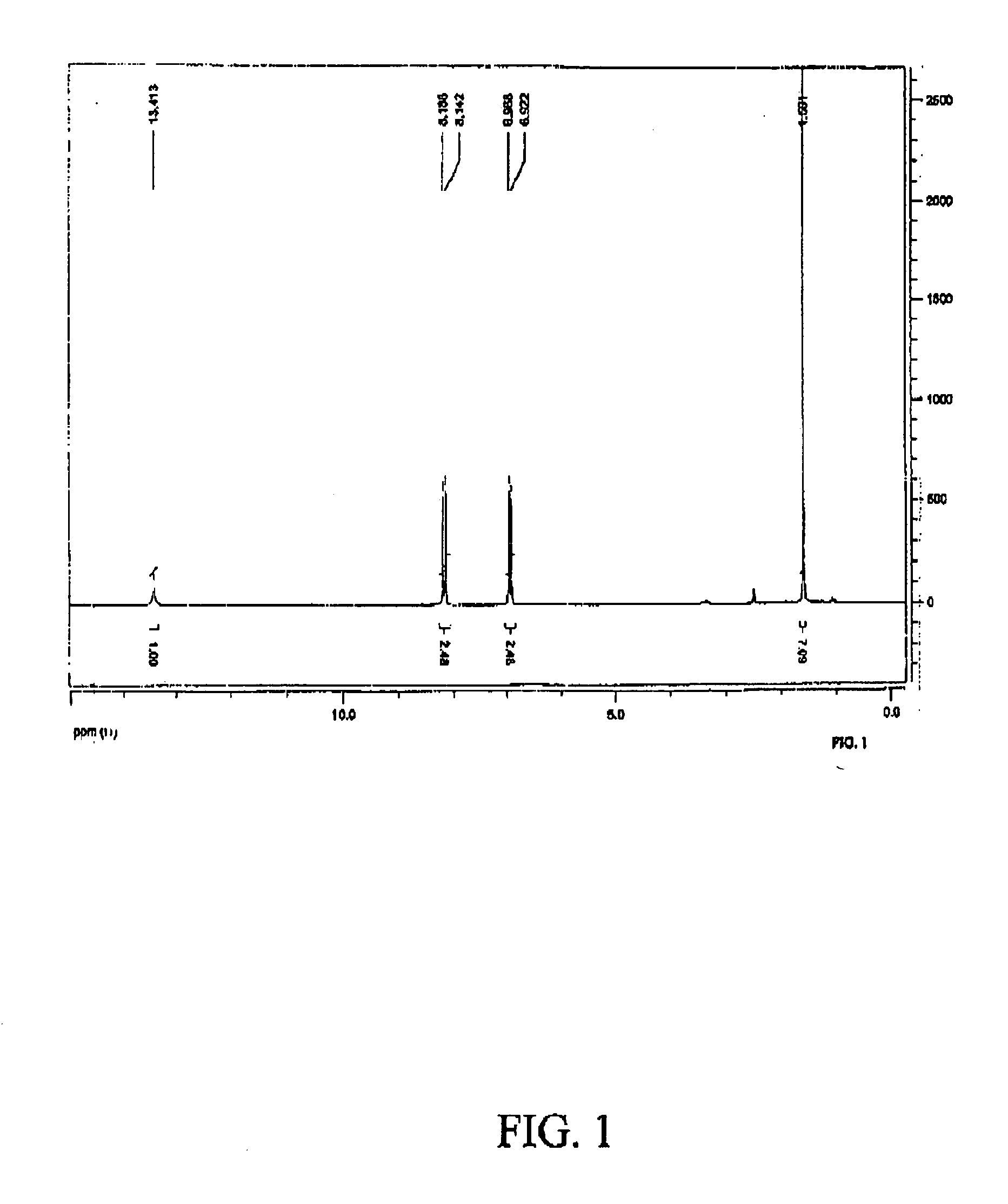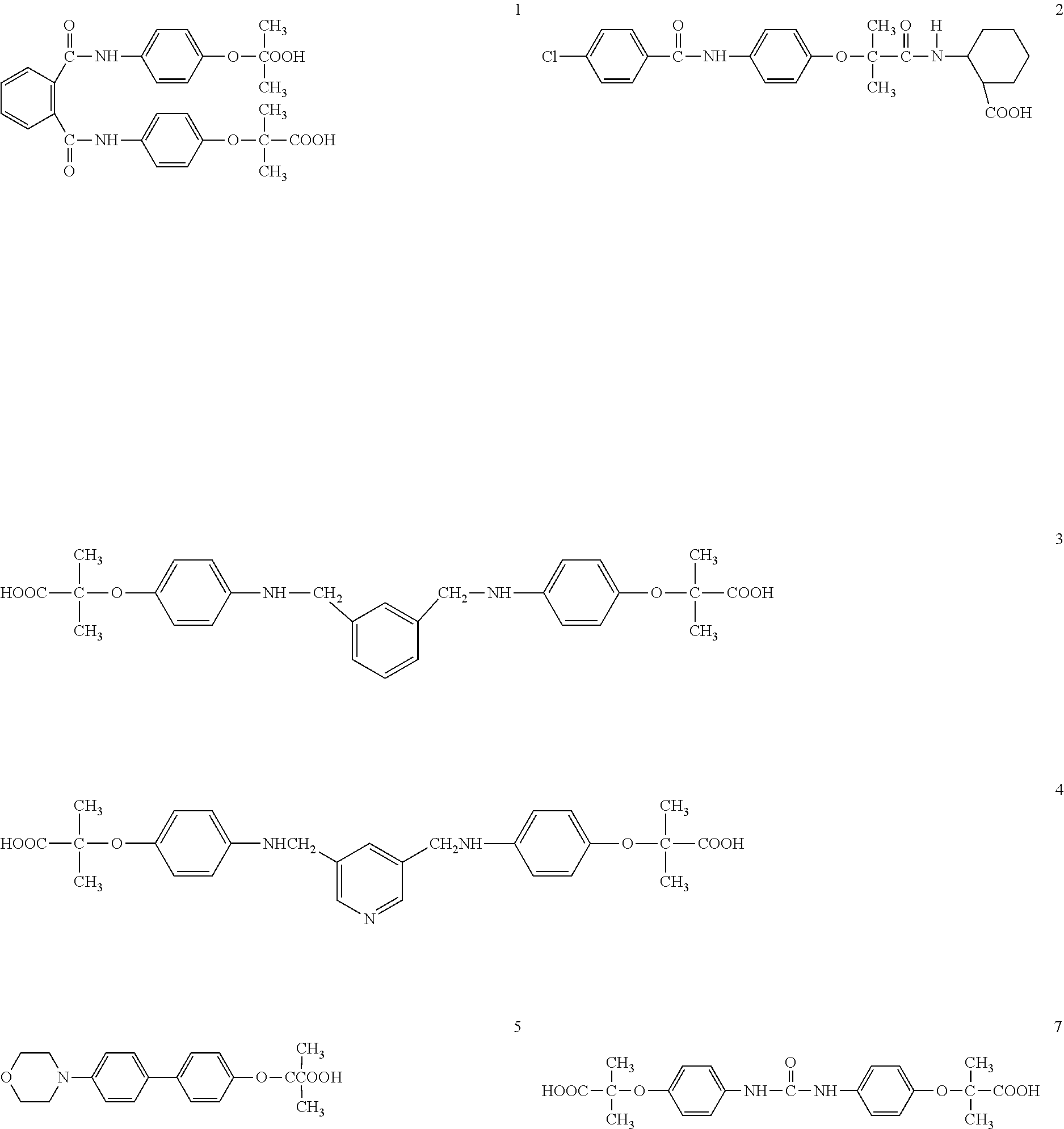Derivatives of phenoxyisobutyric acid
a technology of phenoxyisobutyric acid and derivatives, which is applied in the direction of biocide, drug composition, peptide/protein ingredients, etc., can solve the problems of severe structural and functional changes in protein/protein and protein/cell interaction in the vascular wall, severe consequences on affected organs, and inability to fully understand the mechanisms of hyperglycemia-induced tissue damage in diabetes
- Summary
- Abstract
- Description
- Claims
- Application Information
AI Technical Summary
Benefits of technology
Problems solved by technology
Method used
Image
Examples
example 1
4-phthaloyldiamidophenoxyisdobutyric acid
[0041]The reaction was carried out at by adding to a solution of 4-aminophenoxyisobutyric acid (9.8 gm) (50 mmol) in 150 ml 2N NaOH (about 15 gm NaOH) cooled to near freezing and while stirring gradually adding about 5.05 gm of phthaloyl dichloride by drop wise addition. After overnight stirring at room temp dithionite (about 1 gm) was added and the reaction mixture was filtered. The solution was acidified with acetic acid to give a precipitate which was washed with water and filtered and then air dried. The white solid was dissolved in boiling isopropanol and was allowed to crystallize in a refrigerator. About 50 ml water was added and the mixture was filtered. MP 218-221° C. Yield about 5.2 gm (98%). C28H28N2O8; MW 548
example 2
4-chlorobenzamidophenoxyisobutyrlamidocyclohexl-1-carboxylic acid
[0042]4-chlorobenzamidophenoxyisobutyric acid (3.25 gm) (1 mmol) was added to a solution of ethylchloroformate (0.1 ml) and triethyamine (0.15 ml) in 10 ml tetrahydrofuran in an ice salt bath with stirring for ½ hr. Then a solution of 1-aminocyclohexane-1- carboxylic acid (1.46 gm) was added and stirring was continued for 1.5 hr and then the tetrahydrofurqan was evaporated followed by the addition of 20 ml water and the solution was cooled in a freezer (4° C.) and then an excess of 1N NaOH was added (about 20 ml) to make the solution alkaline and to dissolve the solid. Most of the tetrahydrofuran) was evaporated and then the solution was diluted with 20 ml of additional water and acidified with acetic acid to give an immediate crystalline compound which was filtered, washed with water and air dried.
Note: The yield was small and low possibly due to the excess of NaOH.
example 3
1,3-dibenzylaminophenoxyisobutyric acid
[0043]1,3-dichlorodimethylbenzene (1.38 gm) (0.01 mol) was added to 4-aminophenoxyisobutyric acid (2.47 gm) (0.02 mol) and K2CO3 (2.76 gm) were dissolved in 25 ml of ethanol (anhydrous, denatured). The mixture was stirred and refluxed for 24 hrs. At the end, water was added and evaporated to remove the ethanol. 1.0 gm dithionite was added, filtered hot and acidified with acetic acid. The compound was solid and the MP 133-135.
PUM
| Property | Measurement | Unit |
|---|---|---|
| smoothness | aaaaa | aaaaa |
| breaking | aaaaa | aaaaa |
| concentration | aaaaa | aaaaa |
Abstract
Description
Claims
Application Information
 Login to View More
Login to View More - R&D
- Intellectual Property
- Life Sciences
- Materials
- Tech Scout
- Unparalleled Data Quality
- Higher Quality Content
- 60% Fewer Hallucinations
Browse by: Latest US Patents, China's latest patents, Technical Efficacy Thesaurus, Application Domain, Technology Topic, Popular Technical Reports.
© 2025 PatSnap. All rights reserved.Legal|Privacy policy|Modern Slavery Act Transparency Statement|Sitemap|About US| Contact US: help@patsnap.com



